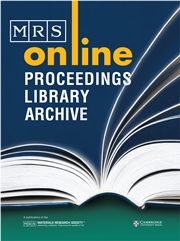No CrossRef data available.
Article contents
The Effect of Hydrogen on an Iron Based Amorphous Alloy
Published online by Cambridge University Press: 15 February 2011
Abstract
In this· investigation we have systematically studied the brittleness and the atomic structure in an Fe(SiBC) alloy. Different amounts of hydrogen have been dissolved in the alloy. It has then been studied at different cooling rates.
Hydrogen gas of different partial pressures was dissolved into the melt. The alloy was then rapidly quenched by a chill block melt spinning method. The cooling rates were changed by changing the velocity on the chilling roll. The brittleness and the atomic structure were examined by bending tests and x-ray diffraction.
X-ray diffractions showed that the ribbons were amorphous when the cooling rate was sufficient. Amorphous ribbons without any hydrogen were ductile, crystalline ribbons of this alloy were brittle. The ribbons with dissolved hydrogen and amorphous structure were brittle even at small amounts of hydrogen. At the highest cooling rates the ribbons with low hydrogen content were ductile. There seems to be a connection between the hydrogen content and the amorphous ribbons ductility. The hydrogen content only has a slight influence to amorphous structure.
- Type
- Research Article
- Information
- Copyright
- Copyright © Materials Research Society 1982




